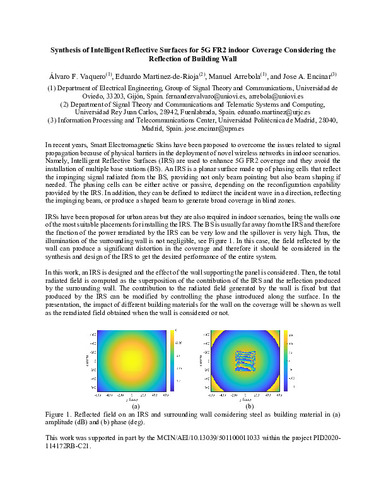Synthesis of Intelligent Reflective Surfaces for 5G FR2 indoor Coverage Considering the Reflection of Building Wall
Autor(es) y otros:
Palabra(s) clave:
reflectarray, intelligent reflecting surface, IRS, metasurface, mm-wave 5G, 5G scenarios
Fecha de publicación:
Resumen:
In recent years, Smart Electromagnetic Skins have been proposed to overcome the issues related to signal propagation because of physical barriers in the deployment of novel wireless networks in indoor scenarios. Namely, Intelligent Reflective Surfaces (IRS) are used to enhance 5G FR2 coverage and they avoid the installation of multiple base stations (BS). An IRS is a planar surface made up of phasing cells that reflect the impinging signal radiated from the BS, providing not only beam pointing but also beam shaping if needed. The phasing cells can be either active or passive, depending on the reconfiguration capability provided by the IRS. In addition, they can be defined to redirect the incident wave in a direction, reflecting the impinging beam, or produce a shaped beam to generate broad coverage in blind zones. In this work, an IRS is designed and the effect of the wall supporting the panel is considered. Then, the total radiated field is computed as the superposition of the contribution of the IRS and the reflection produced by the surrounding wall. The contribution to the radiated field generated by the wall is fixed but that produced by the IRS can be modified by controlling the phase introduced along the surface. In the presentation, the impact of different building materials for the wall on the coverage will be shown as well as the reradiated field obtained when the wall is considered or not.
In recent years, Smart Electromagnetic Skins have been proposed to overcome the issues related to signal propagation because of physical barriers in the deployment of novel wireless networks in indoor scenarios. Namely, Intelligent Reflective Surfaces (IRS) are used to enhance 5G FR2 coverage and they avoid the installation of multiple base stations (BS). An IRS is a planar surface made up of phasing cells that reflect the impinging signal radiated from the BS, providing not only beam pointing but also beam shaping if needed. The phasing cells can be either active or passive, depending on the reconfiguration capability provided by the IRS. In addition, they can be defined to redirect the incident wave in a direction, reflecting the impinging beam, or produce a shaped beam to generate broad coverage in blind zones. In this work, an IRS is designed and the effect of the wall supporting the panel is considered. Then, the total radiated field is computed as the superposition of the contribution of the IRS and the reflection produced by the surrounding wall. The contribution to the radiated field generated by the wall is fixed but that produced by the IRS can be modified by controlling the phase introduced along the surface. In the presentation, the impact of different building materials for the wall on the coverage will be shown as well as the reradiated field obtained when the wall is considered or not.
Descripción:
URSI International Symposium on Electromagnetic Theory (2023. Vancouver, BC, Canada )
Patrocinado por:
This work was supported in part by the MCIN/AEI/10.13039/501100011033 within the project PID2020-114172RB-C21.
Colecciones
Ficheros en el ítem





